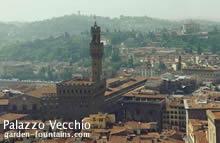Located in the back of the Medicean Villa of Poggio a Caiano, an additional grotto fountain, of formal nature was often attributed to Giulian da Sangallo, an architect of the villa. Large outdoor wall fountains are grouped together to create this grotto that is located between two sets of stairs and is behind four pagan figures. It is believed that figurines may have once lived within the niches, but no one can be sure as no statues remain. Pipes from jets that were located in the wall fountains in the pavement give us belief that the set back area was once a grotto. It is believed that these fountains can possibly date to the second part of the Cinquecento. It is also thought that Ammannati could have created these fountains. He had returned to Florence after the death of Julius III in 1555. He was given work orders from Cosimo I to create outdoor wall fountains to be located at the end of the Sala del Gran Consigilo of the Palazzo Vecchio. This located was on the opposite side of the one that had been created by Bandinelli at an earlier date.
 Marble statues were to be located as decoration around the large outdoor wall fountains. Ammannati created the designs of the sculptures, but the fountains themselves were never completed. During the reign of the next duke, Francesco dei Medici, in 1579, the statues were questioned and were placed in his favorite villa which was located at Pratolino, located above a freestanding fountain. In 1587, Ferdinando enjoyed the wall fountain a great deal and had it moved to the Pitti Palace. During 1588 while workers were preparing the statuary for their new home in the terrace that was located above the grotto, it was recognized that they were be looking at the amphitheater of the Boboli Garden.
Marble statues were to be located as decoration around the large outdoor wall fountains. Ammannati created the designs of the sculptures, but the fountains themselves were never completed. During the reign of the next duke, Francesco dei Medici, in 1579, the statues were questioned and were placed in his favorite villa which was located at Pratolino, located above a freestanding fountain. In 1587, Ferdinando enjoyed the wall fountain a great deal and had it moved to the Pitti Palace. During 1588 while workers were preparing the statuary for their new home in the terrace that was located above the grotto, it was recognized that they were be looking at the amphitheater of the Boboli Garden.
The fountains were installed by the worked in 1590, over outdoor wall fountains. These water features remained until about 1639 and were replaceed by Francesco Susini's Fountain of the Artichokes. Once taken apart, the statues themselves were broken apart and minimal connection is made to the original set of features they were to flank. References were made in letters and books in later years, and all five statues were actually discussed by Dr. Friedrich Kriegbaum.
Page: 1,2, 3, 4, 5, 6, 7, 8, 9, 10, 11, 12
